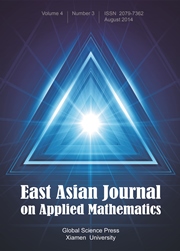No CrossRef data available.
Article contents
An Adaptive Time Stepping Method for Transient Dynamic Response Analysis
Part of:
Partial differential equations, initial value and time-dependent initial-boundary value problems
Published online by Cambridge University Press: 12 May 2016
Abstract
An efficient adaptive time stepping method is proposed for transient dynamic response analysis, which is frequently encountered in civil engineering and elsewhere. The reduced problem following the spatial discretisation can be discretised in the time by a C0-continuous discontinuous Galerkin method, and the adaptive time stepping strategy is based on optimal a posteriori error estimates developed using the energy method. Some numerical experiments demonstrate the effectiveness of our approach.
Keywords
Information
- Type
- Research Article
- Information
- Copyright
- Copyright © Global-Science Press 2016
References
[1]Akrivis, G. and Chatzipantelidis, P., A posteriori error estimates for the two-step backward differentiation formula method for parabolic equations, SIAM J. Num. Anal. 48, 109–132 (2010).CrossRefGoogle Scholar
[2]Akrivis, G., Makridakis, C. and Nochetto, R.H., Galerkin and Runge-Kutta methods: Unified formulation, a posteriori error estimates and nodal super convergence, Num. Math. 118, 429–456 (2011).CrossRefGoogle Scholar
[3]Aksu, G. and Ali, R., Free vibration analysis of stiffened plates using finite difference method, J. Sound Vib. 48, 15–25 (1976).Google Scholar
[4]Arora, V., Direct structural damping identification method using complex FRFs, J. Sound Vib. 339, 304–323 (2015).Google Scholar
[5]Caughey, T. and Okelly, M., Classical normal modes in damped linear dynamic systems, J. Appl. Mech. 32, 583–588 (1965).CrossRefGoogle Scholar
[6]Chen, Z. and Feng, J., An adaptive finite element algorithm with reliable and efficient error control for linear parabolic problems, Math. Comp. 73, 1167–1193 (2004).CrossRefGoogle Scholar
[7]Clough, R.W. and Penzien, J., Dynamics of Structures, Third Edition, Computers & Structures, Inc. (2003).Google Scholar
[8]Cronin, D., Eigenvalue and eigenvector determination for nonclassically damped dynamic systems, Comp. Struct. 36, 133–138 (1990).CrossRefGoogle Scholar
[9]Farhat, C. and Wilson, E., Modal superposition dynamic analysis on concurrent multiprocessors, Eng. Comp. 3, 305–311 (1986).Google Scholar
[10]Feng, X., Tang, T. and Yang, J., Long time numerical simulations for phase-field problems using p-adaptive spectral deferred correction methods, SIAM J. Sci. Comp. 37, A271-A294 (2015).Google Scholar
[11]French, D.A., A space-time finite element method for the wave equation, Comp. Meth. Appl. Mech. Eng. 107, 145–157 (1993).Google Scholar
[12]Heyliger, P. and Reddy, J., A higher order beam finite element for bending and vibration problems, J. Sound Vib. 126, 309–326 (1988).CrossRefGoogle Scholar
[13]Huang, J., Lai, J. and Tang, T., An adaptive time stepping method with efficient error control for second-order evolution problems, Sci. China Math. 56, 2753–2771 (2013).CrossRefGoogle Scholar
[14]Hughes, T.J., The Finite Element Method: Linear Static and Dynamic Finite Element Analysis, Dover (2012).Google Scholar
[15]Hughes, T.J. and Hulbert, G.M., Space-time finite element methods for elastodynamics: Formulations and error estimates, Comp. Meth. Appl. Mech. Eng. 66, 339–363 (1988).CrossRefGoogle Scholar
[16]Hulbert, G.M., Hughes, T.J., Space-time finite element methods for second-order hyperbolic equations, Comp. Meth. Appl. Mech. Eng. 84, 327–348 (1990).Google Scholar
[17]Itoh, T., Damped vibration mode superposition method for dynamic response analysis, Earthquake Eng. Struct. Dyn. 2, 47–57 (1973).Google Scholar
[18]Johnson, C., Discontinuous Galerkin finite element methods for second order hyperbolic problems, Comp. Meth. Appl. Mech. Eng. 107, 117–129 (1993).CrossRefGoogle Scholar
[19]Komatitsch, D., Barnes, C. and Tromp, J., Simulation of anisotropic wave propagation based upon a spectral element method, Geophysics 65, 1251–1260 (2000).Google Scholar
[20]Krawczuk, M., Palacz, M. and Ostachowicz, W., The dynamic analysis of a cracked Timoshenko beam by the spectral element method, J. Sound Vib. 264, 1139–1153 (2003).Google Scholar
[21]Lai, J. and Huang, J., An adaptive linear time stepping algorithm for second-order linear evolution problems, Int. J. Num. Anal. Mod. 12, 230–253 (2015).Google Scholar
[22]Lai, J., Huang, J. and Chen, C., Vibration analysis of plane elasticity problems by the c0-continuous time stepping finite element method, Appl. Num. Math. 59, 905–919 (2009).CrossRefGoogle Scholar
[23]Lai, J., Huang, J. and Shi, Z., Vibration analysis for elastic multi-beam structures by the c0-continuous time-stepping finite element method, Int. J. Num. Meth. Bio. 26, 205–233 (2010).Google Scholar
[24]Li, X.D. and Wiberg, N.-E., Structural dynamic analysis by a time-discontinuous Galerkin finite element method, Int. J. Num. Meth. Eng. 39, 2131–2152 (1996).3.0.CO;2-Z>CrossRefGoogle Scholar
[25]Liu, M. and Gorman, D., Formulation ofRayleigh damping and its extensions, Comp. Struct. 57, 277–285 (1995).Google Scholar
[26]Nochetto, R.H., Savaré, G. and Verdi, C., A posteriori error estimates for variable time-step discretizations of nonlinear evolution equations, Commun. Pure Appl. Math. 53, 525–589 (2000).Google Scholar
[27]Numayr, K.S., Haddad, R.H. and Haddad, M.A., Free vibration of composite plates using the finite difference method, Thin-Walled Struct. 42, 399–414 (2004).Google Scholar
[28]Olsen, G.R. and Vanderplaats, G.N., Method for nonlinear optimization with discrete design variables, AIAA J. 27, 1584–1589 (1989).Google Scholar
[29]Qiao, Z., Zhang, Z. and Tang, T., An adaptive time-stepping strategy for the molecular beam epitaxy models, SIAM J. Sci. Comp. 33, 1395–1414 (2011).CrossRefGoogle Scholar
[30]Saravanos, D.A., Heyliger, P.R. and Hopkins, D.A., Layerwise mechanics and finite element for the dynamic analysis of piezoelectric composite plates, Int. J. Solids Struct. 34, 359–378 (1997).CrossRefGoogle Scholar
[31]Stoer, J. and Bulirsch, R., Introduction to Numerical Analysis, Vol. 12, Springer Science & Business Media (2002).CrossRefGoogle Scholar
[32]Zhang, Z. and Qiao, Z., An adaptive time-stepping strategy for the Cahn-Hilliard equation, Commun. Comp. Phys. 11, 1261–1278 (2012).CrossRefGoogle Scholar
[33]Zhang, Z., Ma, Y. and Qiao, Z., An adaptive time-stepping strategy for solving the phase field crystal model, J. Comp. Phys. 249, 204–215 (2013).Google Scholar

